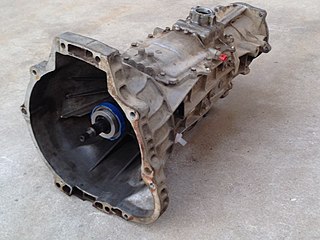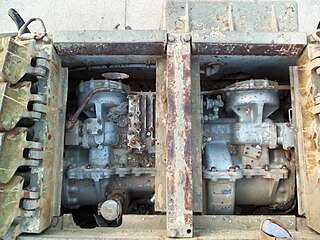
The Mini is a small, two-door, four-seat car, developed as ADO15, and produced by the British Motor Corporation (BMC) and its successors, from 1959 until 2000. Minus a brief hiatus, original Minis were built for four decades and sold during five, from the last year of the 1950s into the last year of the 20th century, over a single generation, as fastbacks, estates, and convertibles.

An automatic transmission is a multi-speed transmission used in motor vehicles that does not require any input from the driver to change forward gears under normal driving conditions. Vehicles with internal combustion engines, unlike electric vehicles, require the engine to operate in a narrow range of rates of rotation, requiring a gearbox, operated manually or automatically, to drive the wheels over a wide range of speeds.

Overdrive is the operation of an automobile cruising at sustained speed with reduced engine speed (rpm), leading to better fuel consumption, lower noise, and lower wear. The term is ambiguous. The most fundamental meaning is that of an overall gear ratio between engine and wheels, such that the car is over-geared, and cannot reach its potential top speed, i.e. the car could travel faster if it were in a lower gear, with the engine turning at higher RPM.

A transmission is a mechanical device which uses a gear set—two or more gears working together—to change the speed or direction of rotation in a machine. Many transmissions have multiple gear ratios, but there are also transmissions that use a single fixed-gear ratio.

A manual transmission (MT), also known as manual gearbox, standard transmission, or stick shift, is a multi-speed motor vehicle transmission system, where gear changes require the driver to manually select the gears by operating a gear stick and clutch.
A semi-automatic transmission is a multiple-speed transmission where part of its operation is automated, but the driver's input is still required to launch the vehicle from a standstill and to manually change gears. Semi-automatic transmissions were almost exclusively used in motorcycles and are based on conventional manual transmissions or sequential manual transmissions, but use an automatic clutch system. But some semi-automatic transmissions have also been based on standard hydraulic automatic transmissions with torque converters and planetary gearsets.

The Ferrari Mondial is a mid-engined, V8, grand tourer manufactured and marketed by Ferrari between 1980 and 1993 – with styling by Pininfarina and bodywork by Carrozzeria Scaglietti.
RPE RP-V8 is the name of a naturally-aspirated V8 engine series developed by Radical Sportscars in Peterborough, England for use in the SR8 sportscar. The design is loosely based on the 1.3 litres (79.3 cu in) inline-four engine produced by Suzuki for their Hayabusa motorcycle. The company have designed their own cylinder block and use existing Suzuki cylinder heads. The two cylinder banks are inclined at 72-degree angle. Lubrication is provided by a dry sump system. The engine is mated to a purpose-built transaxle designed by Quaife.

The Austin Motor Company A-series is a British small straight-4 automobile engine. Launched in 1951 with the Austin A30, production lasted until 2000 in the Mini. It used a cast-iron block and cylinder head, and a steel crankshaft with three main bearings. The camshaft ran in the cylinder block, driven by a single-row chain for most applications, and with tappets sliding in the block, accessible through pressed steel side covers for most applications, and with overhead valves operated through rockers. The cylinder blocks are not interchangeable between versions intended for conventional end-on mounted gearboxes and the 'in-sump' transaxle used on British Motor Corporation/British Leyland front wheel drive models such as the Mini. The cylinder head for the overhead-valve version of the A-series engine was designed by Harry Weslake – a cylinder head specialist famed for his involvement in SS (Jaguar) engines and several Formula One-title winning engines. Although a "clean sheet" design, the A-series owed much to established Austin engine design practise, resembling in general design and overall appearance a scaled-down version of the 1200cc overhead-valve engine first seen in the Austin A40 Devon which would form the basis of the later B-series engine.

Hydramatic is an automatic transmission developed by both General Motors' Cadillac and Oldsmobile divisions. Introduced in 1939 for the 1940 model year vehicles, the Hydramatic was the first mass-produced fully-automatic transmission developed for passenger automobile use.

TorqueFlite is the trademarked name of Chrysler Corporation's automatic transmissions, starting with the three-speed unit introduced late in the 1956 model year as a successor to Chrysler's two-speed PowerFlite. In the 1990s, the TorqueFlite name was dropped in favor of alphanumeric designations, although the latest Chrysler eight-speed automatic transmission has revived the name.

A direct-shift gearbox is an electronically controlled, dual-clutch, multiple-shaft, automatic gearbox, in either a transaxle or traditional transmission layout, with automated clutch operation, and with fully-automatic or semi-manual gear selection. The first dual-clutch transmissions were derived from Porsche in-house development for the Porsche 962 in the 1980s.

A sprag clutch is a one-way freewheel clutch. It resembles a roller bearing but, instead of cylindrical rollers, non-revolving asymmetric figure-eight shaped sprags, or other elements allowing single direction rotation, are used. When the unit rotates in one direction the rollers slip or free-wheel, but when a torque is applied in the opposite direction, the sprags tilt slightly, producing a wedging action and binding because of friction.

The BMC E-series engine is a line of straight-4 and straight-6 overhead camshaft automobile petrol engines from the British Motor Corporation (BMC). It displaced 1.5 L or 1.8 L in four-cylinder form, and 2.2 L or 2.6 L as a six-cylinder. The company's native United Kingdom market did not use the 2.6 L version, which was used in vehicles of Australian and South African manufacture. Although designed when the parent company was BMC, by the time the engine was launched the company had become British Leyland (BL), and so the engine is commonly referred to as the British Leyland E-series engine.

The Mark I Mini (1959–1967) was the first version of British Motor Corporation's Mini model. It is characterised by its sliding windows, external door hinges and "moustache" grille. In the United Kingdom the Mark I was produced between 1959 and 1967 at the Longbridge Plant near BMC's headquarters, with production in Australia continuing until 1970. The Mini Mark I was sold under both Austin and Morris marque names.
ATTESA is a four-wheel drive system used in some automobiles produced by the Japanese automaker Nissan, including some models under its luxury marque Infiniti.

A cross-drive steering transmission is a transmission, used in tracked vehicles to allow precise and energy-efficient steering.

A motorcycle transmission is a transmission created specifically for motorcycle applications. They may also be found in use on other light vehicles such as motor tricycles and quadbikes, go-karts, offroad buggies, auto rickshaws, mowers, and other utility vehicles, microcars, and even some superlight racing cars.

Car controls are the components in automobiles and other powered road vehicles, such as trucks and buses, used for driving and parking.














